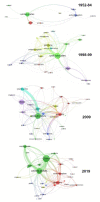A Global View on Block Copolymers
- PMID: 32290129
- PMCID: PMC7240606
- DOI: 10.3390/polym12040869
A Global View on Block Copolymers
Abstract
In this systematic review, a total of 45,143 publications on block copolymers, issued between 1952 and 2019, are analyzed in terms of number, source, language, institution, country, keywords, and block copolymer type, to find out their evolution and predict research trends. The number of publications devoted to block copolymers has been growing for over six decades, maintaining a consistent level throughout the last few years. In their majority, documents came out of the United States, although more recently, Chinese institutions are those displaying the largest production. Keywords analysis indicated that one-third of the publications concerned synthesis, around 20% explored self-assembly and morphological aspects, and another 20% referred to block copolymer applications in solution. In particular, 2019 confirmed the expansion of studies related to drug delivery, and in minor extent, to a deeper view of self-assembling. Styrene-butadiene-styrene block copolymer was the most popular in studies covering both basic and industrially oriented aspects. Other highly investigated copolymers are PEO-b-PPO-b-PEO (Pluronic©) and amphiphilic block copolymers based on polycaprolactone or poly(lactic acid), which owed their success to their potential as delivery vehicles. Future trending topics will concern nanomedicine challenges and technology-related applications, with a special attention toward the orientation and ordering of mesophase-separated morphologies.
Keywords: PS-b-PMMA; drug delivery; nanomaterials; poly(ethylene oxide); self-assembly.
Conflict of interest statement
The authors declare no conflict of interest.
Figures












Similar articles
-
Synthesis and characterization of self-assembling block copolymers containing bioadhesive end groups.Biomacromolecules. 2002 Mar-Apr;3(2):397-406. doi: 10.1021/bm015650p. Biomacromolecules. 2002. PMID: 11888328
-
Poly(ethylene oxide)-poly(propylene oxide)-poly(ethylene oxide) (Pluronic)/poly(epsilon-caprolactone) (PCL) amphiphilic block copolymeric nanospheres. I. Preparation and characterization.J Control Release. 1999 Dec 6;62(3):381-92. doi: 10.1016/s0168-3659(99)00167-4. J Control Release. 1999. PMID: 10528075
-
Modification of the lyotropic liquid crystalline microstructure of amphiphilic block copolymers in the presence of cosolvents.Adv Colloid Interface Sci. 2001 Jan 29;89-90:351-82. doi: 10.1016/s0001-8686(00)00049-x. Adv Colloid Interface Sci. 2001. PMID: 11215804
-
PEO-PPO-PEO Tri-Block Copolymers for Gene Delivery Applications in Human Regenerative Medicine-An Overview.Int J Mol Sci. 2018 Mar 8;19(3):775. doi: 10.3390/ijms19030775. Int J Mol Sci. 2018. PMID: 29518011 Free PMC article. Review.
-
Amphiphilic block copolymers in drug delivery: advances in formulation structure and performance.Expert Opin Drug Deliv. 2018 Nov;15(11):1085-1104. doi: 10.1080/17425247.2018.1529756. Epub 2018 Oct 8. Expert Opin Drug Deliv. 2018. PMID: 30259762 Review.
Cited by
-
Amphiphilic Block Copolymers: Their Structures, and Self-Assembly to Polymeric Micelles and Polymersomes as Drug Delivery Vehicles.Polymers (Basel). 2022 Nov 3;14(21):4702. doi: 10.3390/polym14214702. Polymers (Basel). 2022. PMID: 36365696 Free PMC article. Review.
-
Sulfonated Block Copolymers: Synthesis, Chemical Modification, Self-Assembly Morphologies, and Recent Applications.Polymers (Basel). 2022 Nov 23;14(23):5081. doi: 10.3390/polym14235081. Polymers (Basel). 2022. PMID: 36501479 Free PMC article. Review.
-
Topology and Sequence-Dependent Micellization and Phase Separation of Pluronic L35, L64, 10R5, and 17R4: Effects of Cyclization and the Chain Ends.Polymers (Basel). 2022 Apr 29;14(9):1823. doi: 10.3390/polym14091823. Polymers (Basel). 2022. PMID: 35566993 Free PMC article.
-
S/N/O-Enriched Carbons from Polyacrylonitrile-Based Block Copolymers for Selective Separation of Gas Streams.Polymers (Basel). 2024 Jan 18;16(2):269. doi: 10.3390/polym16020269. Polymers (Basel). 2024. PMID: 38257068 Free PMC article.
-
Vertical Cylinder-to-Lamella Transition in Thin Block Copolymer Films Induced by In-Plane Electric Field.Polymers (Basel). 2021 Nov 16;13(22):3959. doi: 10.3390/polym13223959. Polymers (Basel). 2021. PMID: 34833258 Free PMC article.
References
-
- Hamley I.W. The Physics of Block Copolymers. Oxford University Press; Oxford, UK: 1998.
-
- Fasolka M.J., Mayes A.M. Block Copolymer Thin Films: Physics and Applications. Annu. Rev. Phys. Chem. 2001;31:323–355. doi: 10.1146/annurev.matsci.31.1.323. - DOI
-
- Rodríguez-Hernández J., Chécot F., Gnanou Y., Lecommandoux S. Toward ‘Smart’ Nano-objects by Self-assembly of Block Copolymers in Solution. Progr. Polym. Sci. 2005;30:691–724. doi: 10.1016/j.progpolymsci.2005.04.002. - DOI
-
- Schmidt B.V.K.J. Double Hydrophilic Block Copolymer Self-Assembly in Aqueous Solution. Macromol. Chem. Phys. 2018;219:1700494. doi: 10.1002/macp.201700494. - DOI
Publication types
Grants and funding
LinkOut - more resources
Full Text Sources

